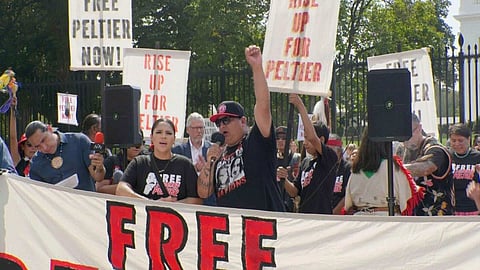'Free Leonard Peltier' Documents the 50-Year Fight to Free an Indigenous Activist
The documentary Free Leonard Peltier opens in a moment of uncertainty.
Activists Holly Cook Macarro (Red Lake Nation) and Nick Tilsen (Oglala Lakota) arrive in Washington, D.C., in 2024 prepared to go to Congress to fight for the freedom of Leonard Peltier, an Indigenous activist and American Indian Movement (AIM) member accused of killing two F.B.I. agents in 1975 and sentenced to back-to-back life sentences.
Throughout his 50 years of incarceration, Peltier has maintained his innocence and hundreds of thousands of people — activists, Indigenous groups, lawyers, celebrities, and even Nelson Mandela — have called for his release, citing tampered evidence and malice used by the government in his conviction. Now at the age of 80 with multiple health concerns, time is running out for Peltier to come home.
"If you're Native American in the United States, you know the story of Leonard Peltier," Cook Macarro said in the film.
"He fought for many of these things we're direct beneficiaries of — cultural resurgence, Native American Freedom of Religion act, Indian Self-Determination Act," added Tilsen. "As long as there has been a movement of the last 50 years, Leonard has been a part of that."
Directed by Jesse Short Bull (Oglala Sioux) and David France, Free Leonard Peltier — screening this weekend at the 51st Seattle International Film Festival — traces Peltier's life, activism, and imprisonment. Using a mix of archival footage, contemporary talking head interviews, and AI recreations, Short Bull and France weave an intriguing and heart-wrenching story about the travesty of justice Peltier and Indigenous communities across the United States have suffered at the hands of the U.S. government.
"All I know is that I am someone that's tried to advocate Indian rights, tried to make a better life for my people, tried to help them," said Peltier in one archival interview from prison in 1989.
The documentary is part breaking news, too. Though Cook Macarro and Tilsen's 2024 D.C. visit was unsuccessful, just a week before the film was to be screened at Sundance earlier this year, President Joe Biden granted Peltier clemency in the final minutes of his presidency. Biden commuted Peltier's sentence to indefinite house arrest on the Turtle Mountain Indian Reservation in North Dakota, where he grew up. Free Leonard Peltier producer Jhane Myers (Comanche and Blackfeet) said they got a tip just four days before the announcement and spent the time calling, texting, and preparing to hopefully bring Peltier home.
"Those four days, it was like a ceremony, which is interesting because ceremonies are usually four days," said Myers in a recent phone call. The news came through just eight minutes before Biden officially left office and the documentary's film crews were immediately on the scene outside the Florida penitentiary where Peltier was being held. Myers is thankful his story "has a happy ending. Because all this time, for 50 years, nine presidents, his story never had a happy ending."
Peltier was born in 1944 on the Turtle Mountain Indian Reservation in North Dakota. The film covers the earlier moments of his life from Peltier's time at an oppressive Indian boarding school in North Dakota to his adult life living in Seattle, working as a welder and construction worker. In 1972, he became involved with the AIM and participated in the Trail of Broken Treaties, protesting the federal government's unjust treatment of Indigenous Americans and calling for "redress for years of failed and destructive federal Indian policies,” according to the National Parks Service.
But the most compelling part of the film is centered around the 1975 shootout that ultimately sent Peltier to prison for five decades. While on Pine Ridge Reservation fighting against the theft of Indigenous land, Peltier and three other AIM members were involved in a shootout on Jumping Bull Ranch that left AIM member Joe Stuntz and FBI agents Ronald Williams and Jack Coler dead. After going into hiding for a year, Peltier was found in Canada and ultimately extradited back to the United States. In 1977, the government pinned Williams and Coler's murder on Peltier and, despite contentious evidence, was sentenced to two life sentences to be served back-to-back.
The documentary utilizes AI to recreate the Pine Ridge Reservation shooting on Jumping Bull Ranch, as well as to sharpen some of the archival footage and sound in the film. "We were able to give Leonard's voice strength," said Myers. "Him being a big leader and an icon, we wanted to make sure that we always showed that warrior strength."
The last hour or so of the film spends time expertly unraveling the federal government's case against Peltier, using evidence amassed by his lawyers and Indigenous activists that they say the feds purposefully suppressed to convict him. It also documents his attempts at being pardoned by the Clinton administration and at various parole hearings over the years. Though most viewers probably already know how the story ends, it's still an often infuriating story to get through, one of injustice and pain. But, for Myers, that makes the resolution all the sweeter.
"I think it's good for people to see that so [they] won't give up," she said. "We never gave up on him as a people and as a culture. Those injustices still happen — but you know, sometimes they get overturned."
"Free Leonard Peltier" is screening on Saturday, May 17, and Sunday, May 18, at SIFF Uptown. It comes to SIFF streaming from May 26 to June 1. Find more information about the film online at SIFF's website.
The Emerald's arts coverage is supported in part with funding from 4 Culture and the City of Seattle's Office of Arts & Culture. The Emerald maintains editorial control over its coverage.
Help keep BIPOC-led, community-powered journalism free — become a Rainmaker today.




